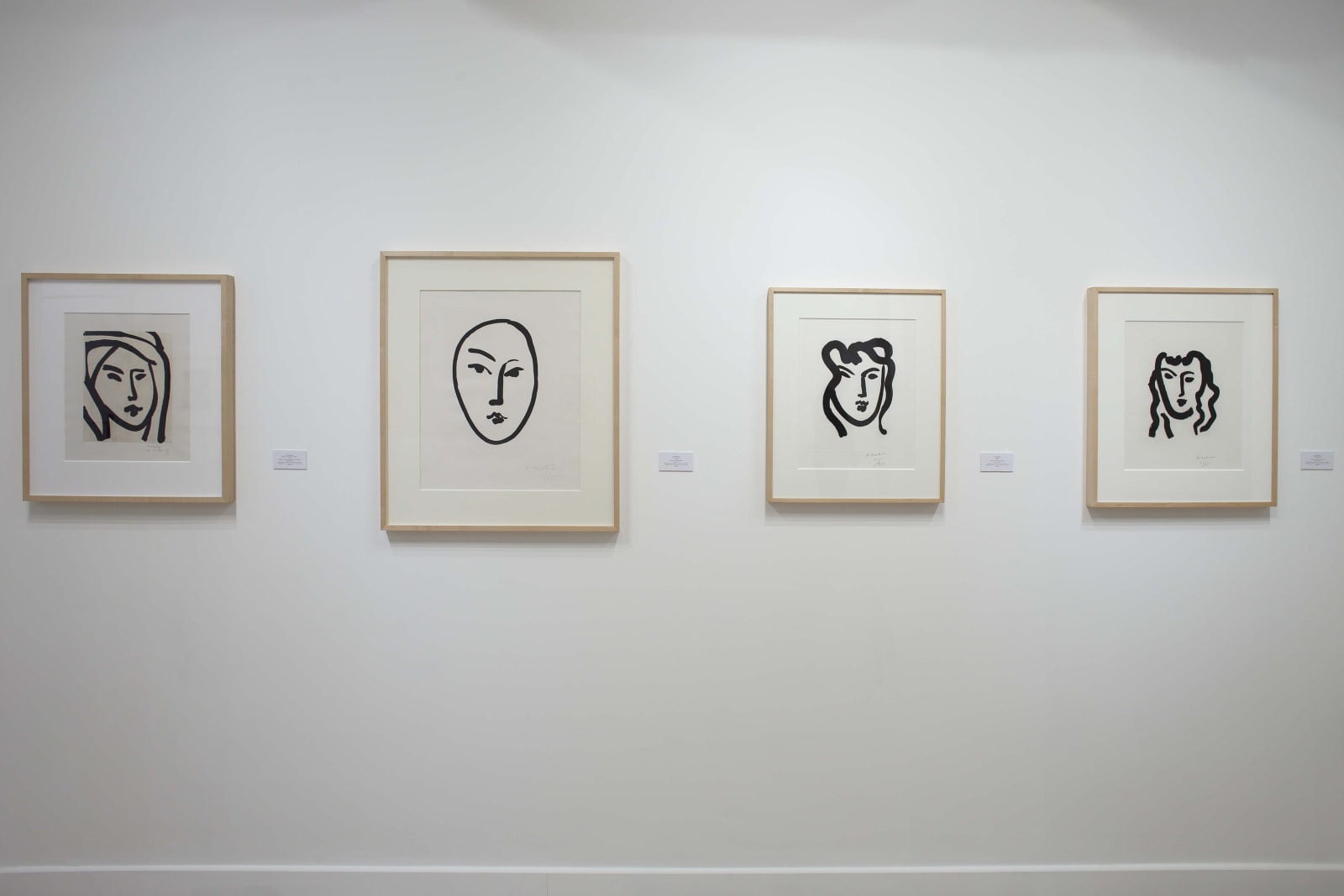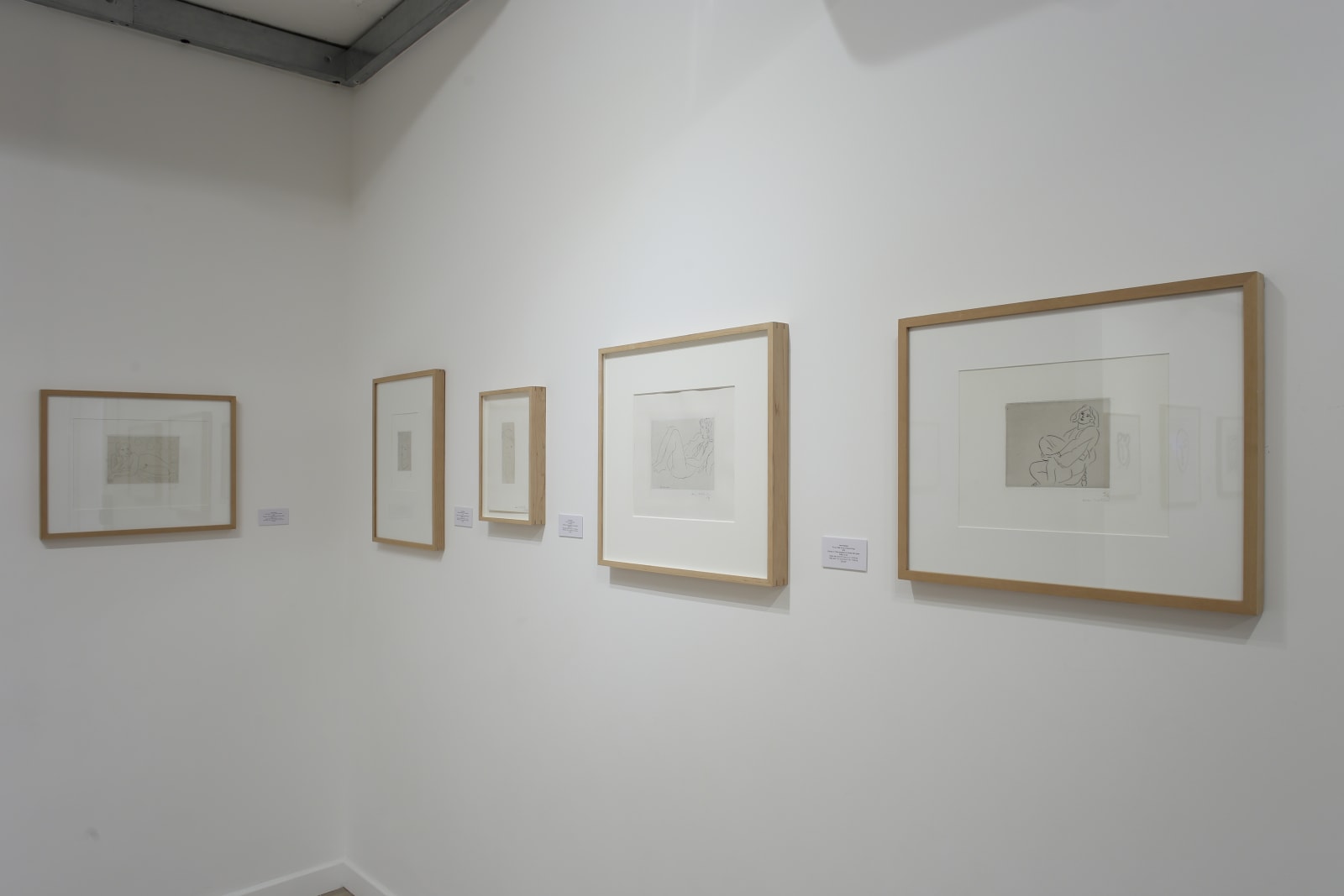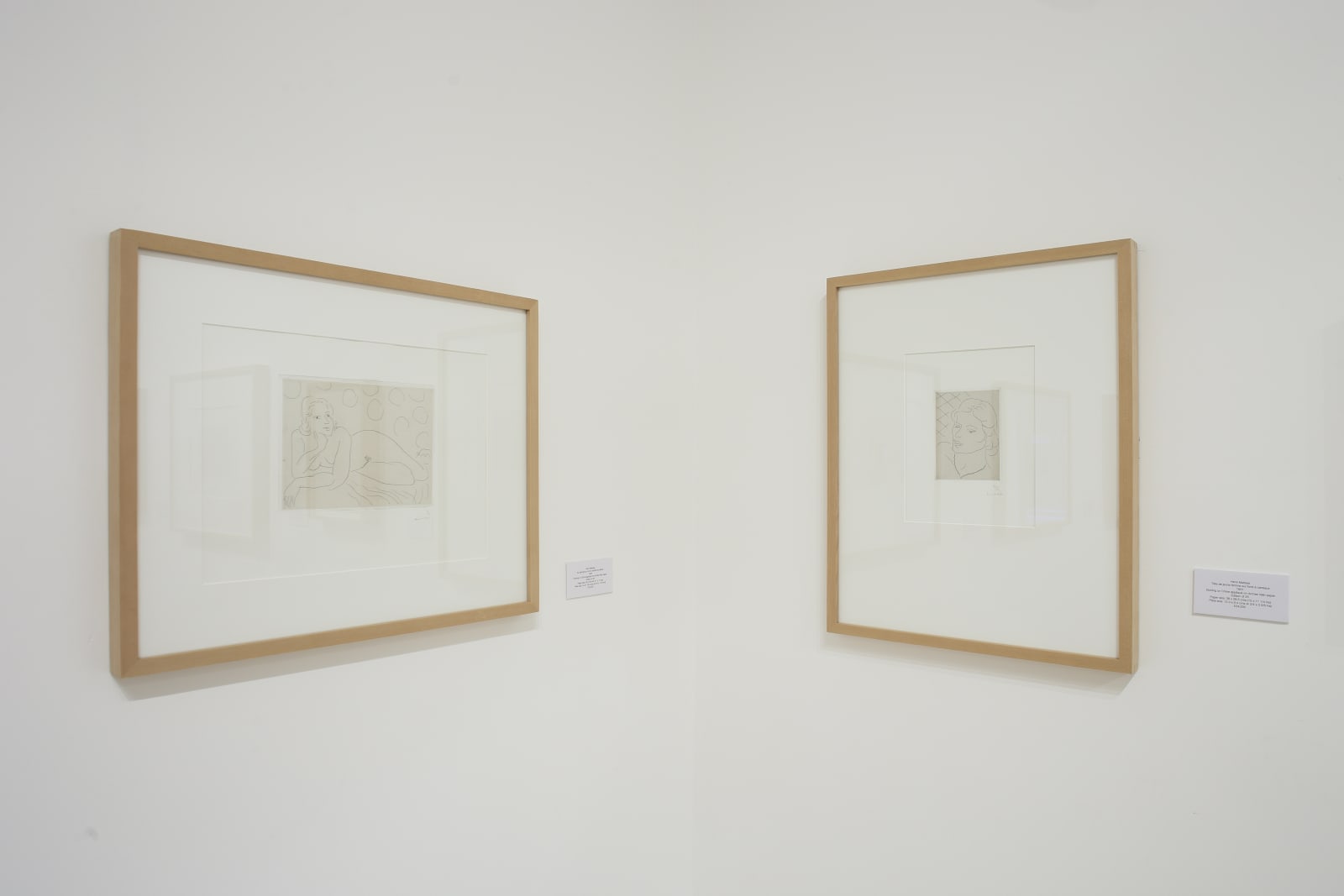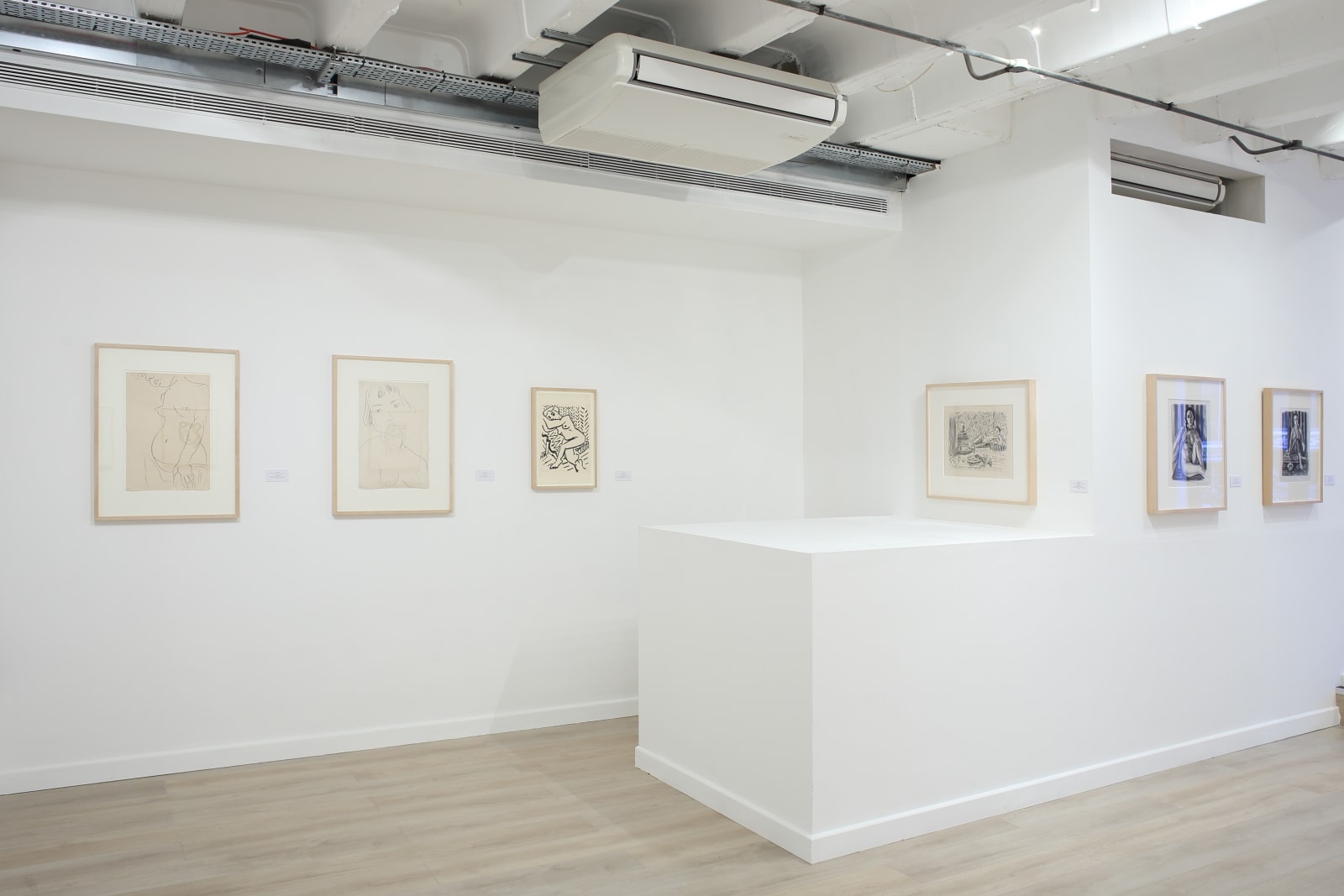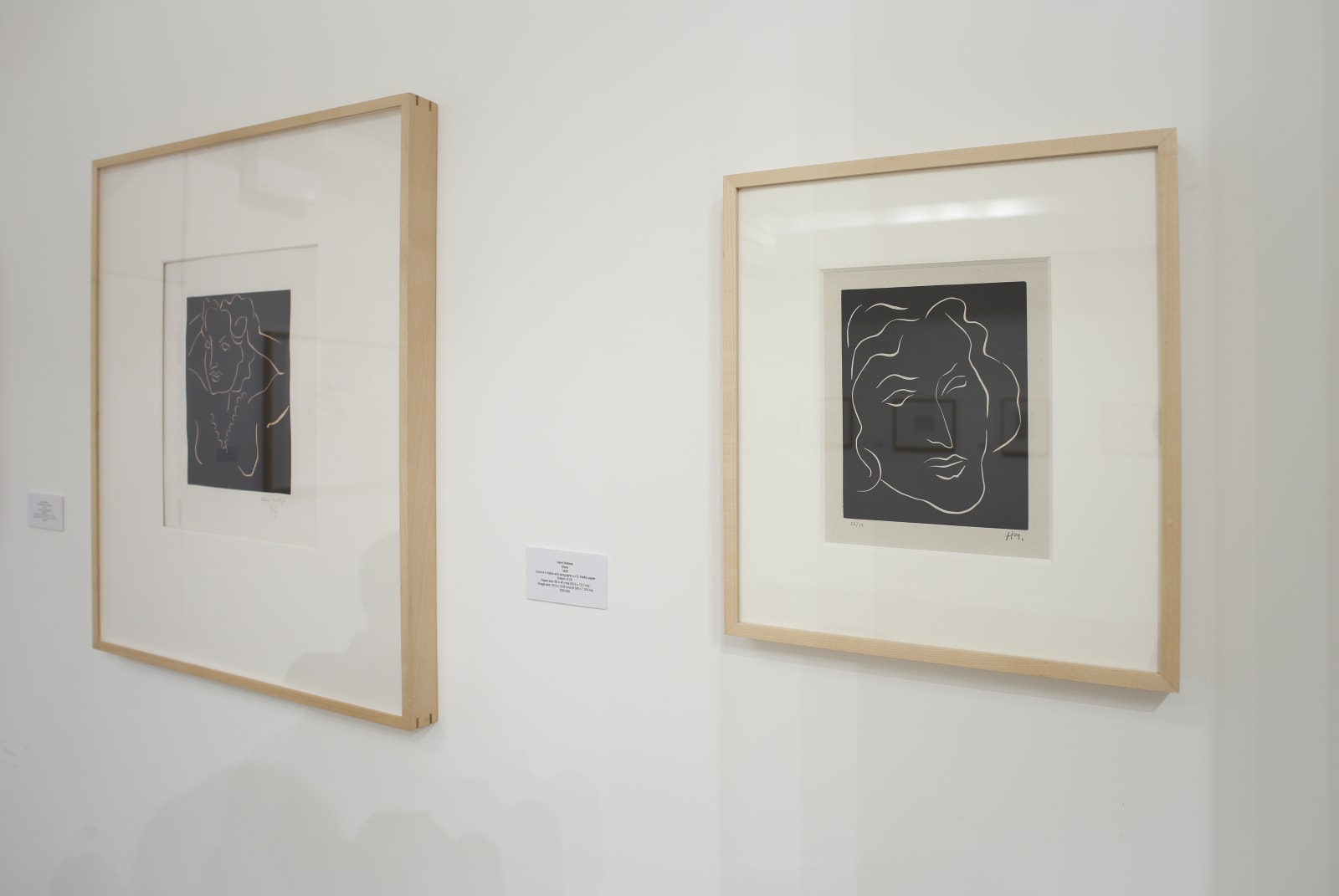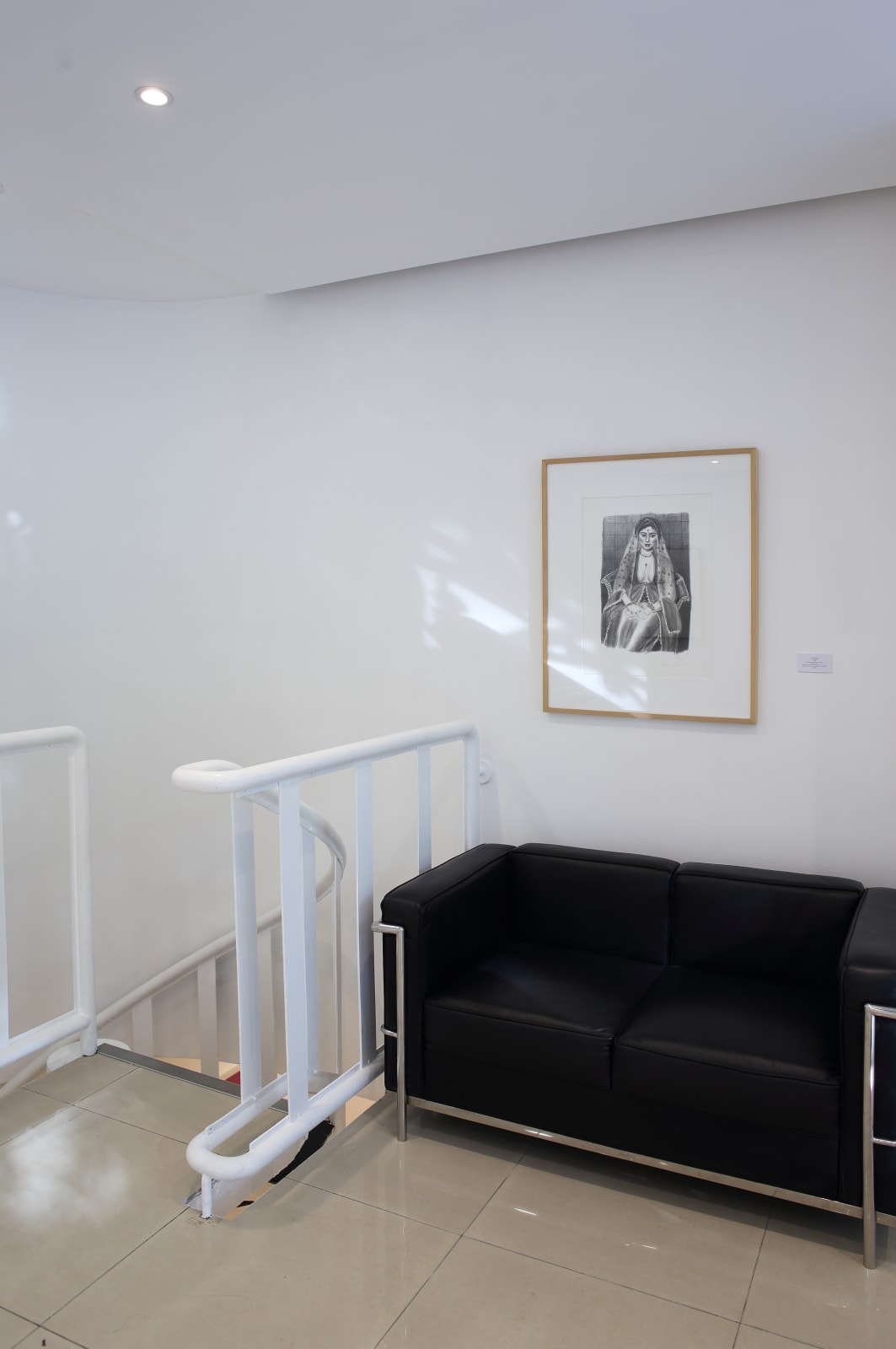Henri Matisse: Prints
-
Bernard Jacobson Gallery presents an expansive new exhibition of aquatints, etchings, linocuts and lithographs by French artist Henri Matisse (1869-1954), charting his dedication to the printed medium through line, light and shadow.
-
Works
-
 Henri MatisseOdalisque à la culotte de satin rouge, 1925Lithograph on Chine paperPaper size: 28.5 x 36.5 cms (11 1/4 x 14 3/8 ins)
Henri MatisseOdalisque à la culotte de satin rouge, 1925Lithograph on Chine paperPaper size: 28.5 x 36.5 cms (11 1/4 x 14 3/8 ins)
Image size: 19 x 27 cms (7 1/2 x 10 5/8 ins) -
 Henri MatisseLe renard blanc, 1929Lithograph on Arches Velin paperPaper size: 66 x 50.5 cms (26 x 19 7/8 ins)
Henri MatisseLe renard blanc, 1929Lithograph on Arches Velin paperPaper size: 66 x 50.5 cms (26 x 19 7/8 ins)
Image size: 51.5 x 36.8 cms ( 20 1/4 x 14 ½ ins) -
 Henri MatisseOdalisque au Magnolia, 1923Lithograph on Japon paperPaper size: 50 x 64.5 cms (9 3/4 x 25 3/4 ins)
Henri MatisseOdalisque au Magnolia, 1923Lithograph on Japon paperPaper size: 50 x 64.5 cms (9 3/4 x 25 3/4 ins)
Image size: 30 x 40.2 cms (11 3/4 x 15 3/4 ins) -
 Henri MatisseNu couché, 1929Etching on Chine appliqué on wove paper28.6 x 38 cms (11 1/8 x 14 5/8 ins)
Henri MatisseNu couché, 1929Etching on Chine appliqué on wove paper28.6 x 38 cms (11 1/8 x 14 5/8 ins) -
 Henri MatisseJeune fille rêvant près d'un bocal de poissons, 1929Etching on Chine appliqué on Arches Vélin paperPaper size: 28 x 38 cms (11 x 15 ins)
Henri MatisseJeune fille rêvant près d'un bocal de poissons, 1929Etching on Chine appliqué on Arches Vélin paperPaper size: 28 x 38 cms (11 x 15 ins)
Plate size: 12.5 x 16.9 cms (5 x 6 5/8 ins) -
 Henri MatisseNu allongé, les jambes repliées, avec un collier, 1929Etching on Chine appliqué on wove paper38 x 28 cms (15 x 11 ins)
Henri MatisseNu allongé, les jambes repliées, avec un collier, 1929Etching on Chine appliqué on wove paper38 x 28 cms (15 x 11 ins) -
 Henri MatisseOdalisque au collier, 1923Lithograph on Chine paper36 x 46 cms (14 3/8 x 18 ins)
Henri MatisseOdalisque au collier, 1923Lithograph on Chine paper36 x 46 cms (14 3/8 x 18 ins) -
 Henri MatisseRepos sur la banquette, 1929Lithograph on Arches Velin paperPaper size: 49.5 x 65.5 cms (19 1/2 x 25 3/4 ins)
Henri MatisseRepos sur la banquette, 1929Lithograph on Arches Velin paperPaper size: 49.5 x 65.5 cms (19 1/2 x 25 3/4 ins)
Image size: 44.5 x 54.5 cms (17 1/2 x 21 1/2 ins) -
 Henri MatisseFigure endormie, châle sur les jambes, 1929Lithograph on Arches Velin paper45 x 55 cms ( 17 3/4 x 21 5/8 ins)
Henri MatisseFigure endormie, châle sur les jambes, 1929Lithograph on Arches Velin paper45 x 55 cms ( 17 3/4 x 21 5/8 ins) -
 Henri MatissePatitcha, 1947Aquatint on BFK Rives paperPaper size: 55.5 x 38 cms (22 x 15 ins)
Henri MatissePatitcha, 1947Aquatint on BFK Rives paperPaper size: 55.5 x 38 cms (22 x 15 ins)
Image size: 34.9 x 27.6 cm (13 3/4 x 10 7/8 ins) -
 Henri MatisseNu pour Cleveland, 1932Etching on Chine appliqué on Arches Velin paperPaper size: 50 x 40 cms (19 5/8 x 15 3/4 ins)
Henri MatisseNu pour Cleveland, 1932Etching on Chine appliqué on Arches Velin paperPaper size: 50 x 40 cms (19 5/8 x 15 3/4 ins)
Plate size: 36.7 x 28.8 cms (14 1/2 x 11 1/4 ins) -
 Henri MatisseOdalisque, brasero et coupe de fruits, 1929Lithograph on Arches Velin paperPaper size: 38 x 57 cms (15 x 22 1/2 ins)
Henri MatisseOdalisque, brasero et coupe de fruits, 1929Lithograph on Arches Velin paperPaper size: 38 x 57 cms (15 x 22 1/2 ins)
Image size: 27.9 x 37.6 cms (11 x 14 7/8 ins) -
 Henri MatisseNu assis à la chemise de tulle, 1925Lithograph on Chine paperPaper size: 55 x 37.2 cms (21 5/8 x 14 5/8 ins)
Henri MatisseNu assis à la chemise de tulle, 1925Lithograph on Chine paperPaper size: 55 x 37.2 cms (21 5/8 x 14 5/8 ins)
Image size: 36.8 x 27.9 cms (14 1/2 x 11 ins) -
 Henri MatisseLou lou au chapeau fleuri, 1914-1915Etching on Chine appliqué on wove paperPaper size: 28 x 18.9 cms (11 x 7 2/5 ins)
Henri MatisseLou lou au chapeau fleuri, 1914-1915Etching on Chine appliqué on wove paperPaper size: 28 x 18.9 cms (11 x 7 2/5 ins)
Plate size: 16 x 6.1 cms (6 1/4 x 2 3/8 ins) -
 Henri MatisseNu au coussin bleu, 1924Lithograph on Arches Velin paperPaper size: 75 x 56 cms (29 1/2 x 22 ins)
Henri MatisseNu au coussin bleu, 1924Lithograph on Arches Velin paperPaper size: 75 x 56 cms (29 1/2 x 22 ins)
Image size: 61.5 x 47.5 cms (24 1/8 x 18 5/8 ins) -
 Henri MatisseNu assis les bras étendus, 1925Lithograph on Japon paperPaper size: 56 x 45.5 (22 x 18 7/8 ins)
Henri MatisseNu assis les bras étendus, 1925Lithograph on Japon paperPaper size: 56 x 45.5 (22 x 18 7/8 ins)
Image size: 49 x 41.5 cms (19.3 x 16.3 ins) -
 Henri MatisseFlorentine, 1938Linocut on Daragnès paperPaper size: 52 x 33 cms (20 1/2 x 13 ins)
Henri MatisseFlorentine, 1938Linocut on Daragnès paperPaper size: 52 x 33 cms (20 1/2 x 13 ins)
image size: 18.5 x 14.3 cms (7 5/8 x 5 5/8 ins) -
 Henri MatisseNu couché. Intérieur à la lampe vénitienne, 1929Etching on Chine appliqué on Arches Velin paper28 x 38 cms (11 x 15 ins)
Henri MatisseNu couché. Intérieur à la lampe vénitienne, 1929Etching on Chine appliqué on Arches Velin paper28 x 38 cms (11 x 15 ins) -
 Henri MatisseGrande masque, 194865.5 x 50 cms (25 7/8 x 19 3/4 ins)
Henri MatisseGrande masque, 194865.5 x 50 cms (25 7/8 x 19 3/4 ins) -
 Henri MatisseNu au miroir marocain, 1929Etching on Chine appliqué on Arches Velin paper37.5 x 28 cms (14 3/4 x 11 ins)
Henri MatisseNu au miroir marocain, 1929Etching on Chine appliqué on Arches Velin paper37.5 x 28 cms (14 3/4 x 11 ins) -
 Henri MatisseOdalisque à la culotte rayée, reflétée dans la glace, 1923Lithograph on Chine paperPaper size: 63 x 47.8 cms (24 13/16 x 18 13/16 ins)
Henri MatisseOdalisque à la culotte rayée, reflétée dans la glace, 1923Lithograph on Chine paperPaper size: 63 x 47.8 cms (24 13/16 x 18 13/16 ins)
Image size: 40 x 30 cms (15 3/4 x 11 3/4 ins) -
 Henri MatisseLa Sieste, 1938Linocut in black and sanguine on G.Maillol paper40.5 x 46 cms (16 x 18 ins)
Henri MatisseLa Sieste, 1938Linocut in black and sanguine on G.Maillol paper40.5 x 46 cms (16 x 18 ins) -
 Henri MatisseDiane, 1938Linocut in black and sanguigne on G. Maillol paperPaper size: 60 x 40 cms (23.6 x 15.7 ins)
Henri MatisseDiane, 1938Linocut in black and sanguigne on G. Maillol paperPaper size: 60 x 40 cms (23.6 x 15.7 ins)
Image size: 23.9 x 19.8 cms (9 3/8 x 7 3/4 ins) -
 Henri MatisseJeune femme, poissons rouges et nappe à carreaux, 1929Etching on Chine appliqué on Arches Velin paperPaper size: 28.5 x 38 cms (11.2 x 15 ins)
Henri MatisseJeune femme, poissons rouges et nappe à carreaux, 1929Etching on Chine appliqué on Arches Velin paperPaper size: 28.5 x 38 cms (11.2 x 15 ins)
Plate size: 12.8 x 18 cms (5 x 7 1/8 ins) -
 Henri MatisseHindoue à la jupe de tulle, 1929Lithograph on Chine paperPaper size: 42 x 51.8 cms (16 ½ x 20 3/8 ins)
Henri MatisseHindoue à la jupe de tulle, 1929Lithograph on Chine paperPaper size: 42 x 51.8 cms (16 ½ x 20 3/8 ins)
Image size: 28.5 x 38 cms (11 1/4 x 15 ins)
-
 Henri MatisseTête de femme en mascaron, 1938Linocut in black and red on G. Maillol paperPaper size: 40 x 30 cms (15 7/8 x 12 ins)
Henri MatisseTête de femme en mascaron, 1938Linocut in black and red on G. Maillol paperPaper size: 40 x 30 cms (15 7/8 x 12 ins)
Image size: 19.2 x 17.3 cms (7 1/2 x 6 7/8 ins) -
 Henri MatisseArabesque, 1924Lithograph on Chine paperPaper size: 62.2 x 46 cms (24 1/2 x 18 1/8 ins)
Henri MatisseArabesque, 1924Lithograph on Chine paperPaper size: 62.2 x 46 cms (24 1/2 x 18 1/8 ins)
Image size: 48.3 x 32 cms (19 x 12 1/2 ins) -
 Henri MatisseLa Persane, 1929Lithograph on Arches Velin paperPaper size: 63 x 44.5 cms (24 3/4 x 17 1/2 ins)
Henri MatisseLa Persane, 1929Lithograph on Arches Velin paperPaper size: 63 x 44.5 cms (24 3/4 x 17 1/2 ins)
Image size: 44.8 x 29 cms (17 5/8 x 11 3/8 ins)
-
 Henri MatisseNu de trois-quarts, une partie de la tête coupée, 1913Lithograph on Japon paperPaper size: 50.2 x 33 cms (19 3/4 x 13 ins)
Henri MatisseNu de trois-quarts, une partie de la tête coupée, 1913Lithograph on Japon paperPaper size: 50.2 x 33 cms (19 3/4 x 13 ins)
Image size: 50.1 x 30.3 cms (19 5/8 x 12 ins) -
 Henri MatisseTorse à l’aiguière, 1927Lithograph on Chine paper
Henri MatisseTorse à l’aiguière, 1927Lithograph on Chine paper
Paper size: 49.5 x 34.5 cms (19 1/2 x 13 1/2 ins)
Image size: 36.4 x 26 cms (14 1/4 x 10 1/4 ins) -
 Henri MatisseOdalisque debout au plateau de fruits, 1924Lithograph on Japon Paper
Henri MatisseOdalisque debout au plateau de fruits, 1924Lithograph on Japon Paper
Paper size: 48 x 32.7 cms (18.9 x 12.9 ins)
Image size: 37.5 x 27.5 cms (14 3/4 x 10 3/4 ins) -
 Henri MatisseVisage de jeune femme, 1948Aquatint on BFK Rives paper
Henri MatisseVisage de jeune femme, 1948Aquatint on BFK Rives paper
Paper size: 55.5 x 38 cms (21 7/8 x 15 ins)
Image size: 34.6 x 27.7 cms ( 13 3/4x11 ins) -
 Henri MatisseFigure au visage coupé assise dans un intérieur, 1929Etching on Chine appliqué on Arches Velin paper
Henri MatisseFigure au visage coupé assise dans un intérieur, 1929Etching on Chine appliqué on Arches Velin paper
Paper size: 28 x 38 cms (11 x 15 ins)
Plate size: 15 x 22.6 cms (6 x 8 7/8 ins) -
 Henri MatisseEtude pour la Vierge, Tête voilée, 1950-51Lithograph on Annam appliqué on Arches Vellum paperPaper size: 50 x 38 cms (19 5/8 x 15 ins)
Henri MatisseEtude pour la Vierge, Tête voilée, 1950-51Lithograph on Annam appliqué on Arches Vellum paperPaper size: 50 x 38 cms (19 5/8 x 15 ins)
Image size: 27.6 x 19.5 cms (10 3/4 x 7 5/8 ins)
-
 Henri MatisseJeune Hindoue, 1929Lithograph on Arches Velin paperPaper size: 39.5 x 49.5 cms (15 1/2 x 19 1/2 ins)
Henri MatisseJeune Hindoue, 1929Lithograph on Arches Velin paperPaper size: 39.5 x 49.5 cms (15 1/2 x 19 1/2 ins)
Image size: 28.5 x 35.8 cms (11 1/4 x 15 ins)
-
 Henri MatisseNu. Étude de torsion du corps, 1926Lithograph on Japon paper
Henri MatisseNu. Étude de torsion du corps, 1926Lithograph on Japon paper
Paper size: 48.3 x 84.5 cms (19 x 33 1/4 ins)
Image size: 43.5 x 79.5 cms (17 1/8 x 31 1/4 ins)
-
 Henri MatisseNu renversé près d'une table Louis XV, 1929Lithograph on Arches Velin paper
Henri MatisseNu renversé près d'une table Louis XV, 1929Lithograph on Arches Velin paper
Paper size: 66 x 50 cms (26 x 19 7/8 ins)
Image size: 55.9 x 46 cms (22 x 18 1/8 ins) -
 Henri MatisseHenri Matisse gravant, 1903Drypoint on Van Gelder paperPaper size: 18 x 27.5 cms (7 x 10 3/4 ins)
Henri MatisseHenri Matisse gravant, 1903Drypoint on Van Gelder paperPaper size: 18 x 27.5 cms (7 x 10 3/4 ins)
Image size: 15 x 19.9 cms (5 7/8 x 7 x 3/4 ins) -
 Henri MatisseFigure endormie aux babouches, 1929Lithograph on Arches Velin paperPaper size: 45 x 54.5 cms (17 3/4 x 21 1/2 ins)
Henri MatisseFigure endormie aux babouches, 1929Lithograph on Arches Velin paperPaper size: 45 x 54.5 cms (17 3/4 x 21 1/2 ins)
Image size: 27.2 x 37.8 cms (10 5/8 x 14 7/8 ins) -
 Henri MatissePatitcha. Masque, 1947Aquatint on BFK Rives paperPaper size: 56.2 x 38.1 cms (22 1/8 x 15 ins)
Henri MatissePatitcha. Masque, 1947Aquatint on BFK Rives paperPaper size: 56.2 x 38.1 cms (22 1/8 x 15 ins)
Image size: 34.6 x 27.4 cms (13 5/8 x 10 7/8 ins) -
 Henri MatisseLa Sieste, 1922Lithograph on Chine paperPaper size: 45 x 57 cms (17 3/4 x 22 1/2 ins)
Henri MatisseLa Sieste, 1922Lithograph on Chine paperPaper size: 45 x 57 cms (17 3/4 x 22 1/2 ins)
Image size: 40.5 x 43.5 cms (16 x 17 1/8 ins) -
 Henri MatisseOdalisque à la coupe de fruits, 1925Lithograph on Chine paperPaper size: 48 x 31.5 cms (19 x 12 3/8 ins)
Henri MatisseOdalisque à la coupe de fruits, 1925Lithograph on Chine paperPaper size: 48 x 31.5 cms (19 x 12 3/8 ins)
Image size: 33.2 x 26 cms (13 x 10 1/4 ins) -
 Henri MatisseOrientale à la croix trifoliée, 1929Lithograph on Arches Velin paperPaper size: 65 x 50.5 cms (25 1/2 x 19 7/8 ins)
Henri MatisseOrientale à la croix trifoliée, 1929Lithograph on Arches Velin paperPaper size: 65 x 50.5 cms (25 1/2 x 19 7/8 ins)
Image size: 54.3 x 45 cms (21 3/8 x 17 3/4 ins) -
 Henri MatisseLa Pompadour ("Pour Versailles"), 1951Lithograph on Chine appliqué on Arches Velin paperPaper size: 54.5 x 38 cms (21.5 x 15 ins)
Henri MatisseLa Pompadour ("Pour Versailles"), 1951Lithograph on Chine appliqué on Arches Velin paperPaper size: 54.5 x 38 cms (21.5 x 15 ins)
Image size: 37.7 x 27.8 cms (14 3/4 x 11 ins) -
 Henri MatisseJeune femme dormant près d'un bocal , 1929Etching on Chine appliqué on Arches Velin paperPaper size: 28 x 38 cms (11 x 15 ins)
Henri MatisseJeune femme dormant près d'un bocal , 1929Etching on Chine appliqué on Arches Velin paperPaper size: 28 x 38 cms (11 x 15 ins)
Plate size: 12.4 x 16.8 cms (4 7/8 x 6 5/8 ins)
-
 Henri MatisseIntérieur, la lecture, 1925Lithograph on Chine paperPaper size: 39 x 31 cms (15.4 x 12.2 ins)
Henri MatisseIntérieur, la lecture, 1925Lithograph on Chine paperPaper size: 39 x 31 cms (15.4 x 12.2 ins)
Image size: 27.2 x 19 cms (11 5/8 x 7 1/2 ins) -
 Henri MatisseNu au collier et aux cheveux longs, 1920Etching on Chine appliqué on Arches Velin paperPaper size: 28 x 37.5 cms (11 x 14.8 ins)
Henri MatisseNu au collier et aux cheveux longs, 1920Etching on Chine appliqué on Arches Velin paperPaper size: 28 x 37.5 cms (11 x 14.8 ins)
Plate size: 15 x 19.4 cms (5 7/8 x 7 5/8 ins) -
 Henri MatisseVisage légèrement penché vers la gauche, 1913Lithograph on Japon paperPaper size: 50 x 33 cms (19 3/8 x 13 ins)
Henri MatisseVisage légèrement penché vers la gauche, 1913Lithograph on Japon paperPaper size: 50 x 33 cms (19 3/8 x 13 ins)
Image size: 49 x 32.2 cms (19.3 x 12.7 ins) -
 Henri MatisseNu couché au paravant Louis XIV, 1923Lithograph on Chine volantPaper size: 28.7 x 37.6 cms (11 5/16 x 14 13/16 ins)
Henri MatisseNu couché au paravant Louis XIV, 1923Lithograph on Chine volantPaper size: 28.7 x 37.6 cms (11 5/16 x 14 13/16 ins)
Image size: 14.1 x 19 cms (5 1/2 x 7 1/2 ins) -
 Henri MatisseNu allongé sur fond à motifs circulaires, 1929Etching on Chine appliqué on Arches Velin paperPaper size: 28 x 38 cms (11 x 15 ins)
Henri MatisseNu allongé sur fond à motifs circulaires, 1929Etching on Chine appliqué on Arches Velin paperPaper size: 28 x 38 cms (11 x 15 ins)
Plate size: 14.8 x 19.8 cms (5 3/4 x 73/4 ins) -
 Henri MatisseBédouine - Souvenir de Manon, 1947Aquatint on annam appliqué on wove paperPaper size: 50 x 38.4 cms (19 5/8 x 15 1/8 ins)
Henri MatisseBédouine - Souvenir de Manon, 1947Aquatint on annam appliqué on wove paperPaper size: 50 x 38.4 cms (19 5/8 x 15 1/8 ins)
Plate size: 31.7 x 25.2 cms (12 1/2 x 9 7/8 ins) -
 Henri MatisseJeune femme enserrant son genou gauche, 1929Drypoint on Chine appliqué on Arches Velin paperPaper size: 28.5 x 38 cms (11 1/4 x 15 ins)
Henri MatisseJeune femme enserrant son genou gauche, 1929Drypoint on Chine appliqué on Arches Velin paperPaper size: 28.5 x 38 cms (11 1/4 x 15 ins)
Plate size: 12.4 x 15.5 cms (4 7/8 x 6 1/8 ins) -
 Henri MatisseLa Belle Tahitienne, 1938Linocut on G. Maillol paperPaper size: 60.5 x 40.5 cms (23 3/4 x 15 7/8 ins)
Henri MatisseLa Belle Tahitienne, 1938Linocut on G. Maillol paperPaper size: 60.5 x 40.5 cms (23 3/4 x 15 7/8 ins)
Image size: 28 x 19.8 cms (11 x 7 3/4 ins) -
 Henri MatisseNadia. Masque souriant, 1948Aquatint on Marais paperPaper size: 52.5 x 38 cms (20 5/8 x 15 ins)
Henri MatisseNadia. Masque souriant, 1948Aquatint on Marais paperPaper size: 52.5 x 38 cms (20 5/8 x 15 ins)
Image size: 31.6 x 25.1 cms (12 1/2 x 9 7/8 ins) -
 Henri MatisseOrientale sur lit de repos, sol de carreaux rouges, 1929Lithograph on Arches paperPaper size: 50.5 x 66 cms (20 x 26 ins)
Henri MatisseOrientale sur lit de repos, sol de carreaux rouges, 1929Lithograph on Arches paperPaper size: 50.5 x 66 cms (20 x 26 ins)
Image size: 26.2 x 47.5 cms (10 3/8 x 18 5/8 ins) -
 Henri MatisseL'Homme endormie, 1936AquatintPaper size: 39 x 28.5 cms (16 x 11 1/8 ins)
Henri MatisseL'Homme endormie, 1936AquatintPaper size: 39 x 28.5 cms (16 x 11 1/8 ins)
Image size: 24.8 x 17.5 cms (9 3/4 x 6 7/8 ins) -
 Henri MatissePetit bois clair, 1906Woodcut on Van Gelder paperPaper size: 46 x 28.5 cms (18 x 11 1/4 ins)
Henri MatissePetit bois clair, 1906Woodcut on Van Gelder paperPaper size: 46 x 28.5 cms (18 x 11 1/4 ins)
Image size: 34.2 x 26.6 cms (13 1/4 x 10 x 1/4 ins) -
 Henri MatisseLa robe d'organdi, 1922Lithograph on Chine paperPaper size: 53.5 x 35.5 cms (21 x 14 ins)
Henri MatisseLa robe d'organdi, 1922Lithograph on Chine paperPaper size: 53.5 x 35.5 cms (21 x 14 ins)
Image size: 42.5 x 27.8 cms (16 3/4 x 11 ins) -
 Henri Matisse, Nadia au profil aigu, 1948
Henri Matisse, Nadia au profil aigu, 1948 -
 Henri MatisseJeune femme, la cordelière de son peignoir en collier, 1929Etching on Chine appliqué on Arches Velin paperPaper size: 28.5 x 38 cms (11 1/4 x 15 ins)
Henri MatisseJeune femme, la cordelière de son peignoir en collier, 1929Etching on Chine appliqué on Arches Velin paperPaper size: 28.5 x 38 cms (11 1/4 x 15 ins)
Plate size: 12.9 x 18 cms (5 x 7 ins) -
 Henri MatisseFanny de face, 1914Etching on Chine appliqué on wove paperPaper size: 28 x 18.7 cms (11 x 7 3/8 ins)
Henri MatisseFanny de face, 1914Etching on Chine appliqué on wove paperPaper size: 28 x 18.7 cms (11 x 7 3/8 ins)
Plate size: 15.9 x 6.1 cms (6 1/4 x 2 3/8 ins) -
 Henri MatisseJeune femme assise, robe sans manches, 1938Dry-point Chine appliqué on vellum paperPaper size: 31.5 x 22.5 cms (12 3/8 x 8 7/8 ins)
Henri MatisseJeune femme assise, robe sans manches, 1938Dry-point Chine appliqué on vellum paperPaper size: 31.5 x 22.5 cms (12 3/8 x 8 7/8 ins)
Plate size: 17.9 x 13 cms (7 x 5 1/8 ins) -
 Henri MatisseTête de jeune femme sur fond à carreaux, 1931Etching on Chine appliqué on Arches Velin paperPaper size: 38 x 28.5 cms (15 x 11 1/4 ins)
Henri MatisseTête de jeune femme sur fond à carreaux, 1931Etching on Chine appliqué on Arches Velin paperPaper size: 38 x 28.5 cms (15 x 11 1/4 ins)
Plate size: 12.3 x 9.4 cms (4 3/4 x 3 5/8 ins) -
 Henri MatissePetite Aurore, 1923Lithograph on Chine paperPaper size: 28.3 x 37.8 cms (11 1/8 x 14 7/8 ins)
Henri MatissePetite Aurore, 1923Lithograph on Chine paperPaper size: 28.3 x 37.8 cms (11 1/8 x 14 7/8 ins)
Image size: 13 x 20.1 cms (5 1/8 x 7 7/8 ins)
-
-
Press Release Text
Bernard Jacobson Gallery is delighted to present Henri Matisse: Prints, an expansive new exhibition chronicling the seminal artist’s evolution in the medium of printmaking from 1900 to 1954. Opening May 2nd, the retrospective sheds light on Matisse's inquiry into the potency of line and shadow across three pivotal phases of his career.
A giant of twentieth century art, Henri Matisse (1869-1954) rose to prominence as a pioneer of Fauvism, a movement that defied traditional representation with its vibrant colours and expressive brushstrokes. Born in Le Cateau-Cambrésis, France, in 1869, his artistic practice encompassed painting, sculpture, and printmaking, all bound by a relentless pursuit of new visual expressions. Matisse endeavoured not to replicate reality, but to evoke its essence. His human subjects are distilled into forms that range from the minimalistic to the delicate, in a palette that never strays from the monochrome.
Matisse's foray into printmaking began in 1900, a time at which he was still establishing himself as an artist. Opening the exhibition, Henri Matisse gravant (1900-1903), a self-portrait drypoint etching, showcases his early experimentation with chiaroscuro, a technique that sees light and shadow balanced to create compositional volume, depth and drama. Further attesting to his early fascination with the potential of monochromatic contrast, the heavily contoured outlines of woodcut Petit bois clair (1906) distinguish its subject from her finely patterned backdrop.
However, it was the turmoil of World War I (1914-1918) that unexpectedly pushed Matisse towards a more dedicated exploration of printmaking. Unable to work on large-scale oil paintings due to the material and practical constraints brought on by international conflict, he turned to the immediacy and intimacy of printmaking. This period, from 1914 to 1917, was to be remarkably prolific for Matisse: within a period of months he produced around fifty etchings, ten lithographs, and more than a dozen monotypes. Works from these pivotal years, such as Fanny de face (1914) and Lou lou au chapeau fleuri (1914-1915), exemplify Matisse’s contemporary focus on the power and energy of line.
Striving toward representation with minimal detail, Matisse stripped away anything extraneous, allowing the effortlessness of his hand movements to define form and evoke emotion. Intriguingly, he would often create monotypes — the inverse of his etchings — using the same copper plate. These 'white line’ monotypes make plain the refined precision of Matisse’s handiwork, as each scratch upon the copper plate finds translation in a stark white stroke on the present prints.
By 1922, a contemplation of light and shadow had become increasingly evident in Matisse's printmaking. This period, marked by the return of relative serenity following Armistice, saw him embrace lithography with renewed enthusiasm. Nu sur chaise de repos sur fond moucharabieh (1922) and Odalisque au Magnolia (1923), for instance, showcase Matisse’s introduction of modulated shading and elaborately detailed background settings – vases, fruits and florals, ornate furnishings – elements he had eschewed from previous compositions.
These reclining nudes, reminiscent of Matisse’s larger paintings, were influenced by his travels across North Africa. Matisse himself articulated this synthesis of lived experience and memory with artistic expression, stating, “Windows have always interested me because they are a passageway between the exterior and the interior. As for odalisques, I hastened them in Morocco, and so was able to put them in my pictures back in France without playing make believe” (Matisse Speak, 1951).
Matisse's later years, marked by declining physical health, saw a renewed exploration of printmaking techniques. By the 1930s he had began experimenting with linocuts, within which designs are carved into linoleum. This technique was particularly well-suited to Matisse’s use of negative space to envelop his subjects. La Belle Tahitienne (1938) and La Sieste (1938) exemplify this approach, capturing the spectrum of his subjects' environments – from the tropical climes of Tahiti to the tranquil dreaminess of a siesta. This period also saw the emergence of his revolutionary aquatints. Patitcha. Masque (1947) and Nadia au profil aigu (1948) are characterised by bold, simplified forms and stark contrasts of light and dark.
Throughout his printmaking career, Matisse maintained his dedication to monochrome, setting himself and his works apart from the vivid palettes of contemporaries Paul Signac and Henri-Edmond Cross, who were known for their large-scale colour lithographs. For Matisse, the limitations intrinsic to black and white became an artistic challenge, pushing the expressive potentials of line, shade, and texture to their fullest realisation. Despite adopting new techniques, the essence of line remained central to Matisse’s oeuvre, embodying his belief that the simplest forms often express the most profound truths. Exploring an array of works across different mediums — from delicate etchings and naturalistic lithographs to dynamic monotypes and bold linocuts — Henri Matisse: Prints offers a unique window into the evolution of a master's artistic vision.
-
Installation Shots



































































